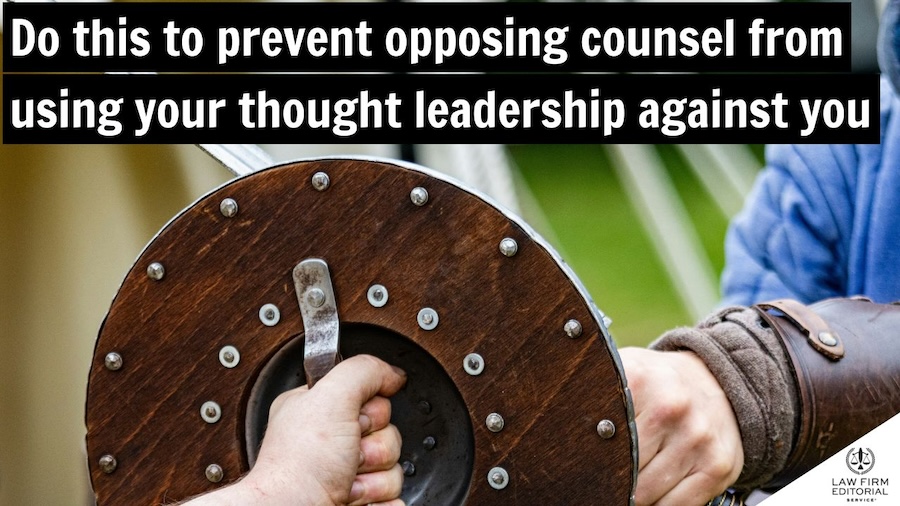There’s a ridiculously simple technique attorneys can employ to prevent opposing counsel from using their thought leadership in court papers against their clients.
It’s not unusual for attorneys in certain legal practices to avoid publishing thought leadership for fear of opposing counsel using it against them and their clients in the future.
But by doing one simple thing—the thing you were taught to do on law school final exams to get the best score—you can prevent opposing counsel from using your thought leadership against you.
That one thing? Argue both sides.
A reasonable fear . . .
The attorneys most likely to have this fear are those who could be on both sides of an issue based on their practice.
Corporate litigators, family law attorneys, and intellectual property attorneys, to name a few types of attorneys who likely fall into this category, might be arguing for a particular interpretation of case law or a statute in one client matter. Down the road, in another matter, they might need to argue for a contradictory interpretation.
While this is not uncommon, attorneys who publicly take an I’m-not-going-to-budge stance regarding the interpretation of a case or statute in an article, blog post, or other piece of thought leadership could be susceptible to a “Gotcha!” attack by opposing counsel looking to embarrass them in court papers or another legal document by citing their thought leadership against them and their clients.
Though this kind of attack is unlikely to score any points with a judge, it can be embarrassing for an attorney when their client sees the legal document and asks why opposing counsel cited the attorney’s thought leadership in support of an argument they’re making against the attorney and the client.
. . . that’s easily conquered
When you’re concerned that this could happen to you if you were to write a thought leadership piece about a particular legal development or a “best practices” piece regarding an issue that comes up often in legal matters you handle, you can alleviate this concern by simply playing both sides.
After you’ve walked through a legal development or set the table regarding the issue you will describe the best practices for handling, when you begin your analysis, make sure you address both sides of your arguments.
Explain why the legal development is notable, discuss what it means for people who might be impacted by the legal development, and then argue against what you just said, the same way you did during your law school final exams.
If you’re writing a best practices article or a similar article that isn’t about a timely legal development, you can introduce opposing views by saying, “On the other hand,” or “Some people would prefer,” or something similar, explaining why there’s a reasonable alternate approach to what you’ve been discussing.
What you want to do is make sure that if opposing counsel came across a particular piece of thought leadership you created, you didn’t come down so forcefully and uncompromisingly on one side of an argument that they could cite your thought leadership against you if you were on the other side of that argument in a particular client matter.
Straddling the fence need not weaken your thought leadership
You might be wondering whether arguing both sides in a piece of thought leadership waters down the piece.
It doesn’t.
I wouldn’t recommend that your thought leadership ALWAYS straddle the fence. If you never took a one-sided position in your thought leadership regarding the topics you cover, you’d miss out on opportunities to show clients that your views of the world sync with theirs.
But in limited instances when you’re discussing in your thought leadership topics you might be on either side of based on your clients’ matters, arguing both sides shouldn’t come back to bite you.
You’re still providing analysis.
You’re still providing guidance and insights.
You’re still explaining the “so what” and the “now what” of a legal development.
You’re still engaging in thought leadership. You’re just giving both sides of your arguments to prevent opposing counsel form using your thought leadership against you and a client.
Don’t throw the thought leadership baby out with the bathwater
For many attorneys, this need to argue both sides won’t ever come into play.
If you have the kind of practice where you’re always representing the same types of clients, such as plaintiffs in personal injury or consumer rights actions, or insurance companies and financial institutions in those actions, you’re not going to have to worry about playing both sides. You’re always going to argue that a particular statute or court decision should be interpreted a particular way because that interpretation will always be favorable for your similarly situated clients (perhaps save for a rare exception).
Don’t let the fear of a piece of thought leadership content being cited against you and your client stop you from writing that piece of thought leadership content.
If you’re ever concerned that opposing counsel could one day use a piece of thought leadership content you’re contemplating creating against a client of yours, simply harken back to the days when you were a law student and argue both sides.
Thinking about bringing on an outside writer to help your law firm strategize and create compelling thought-leadership marketing and business development content? Click here to schedule a 30-minute Content Strategy Audit to learn if collaborating with an outside writer is the right move for you and your firm.

